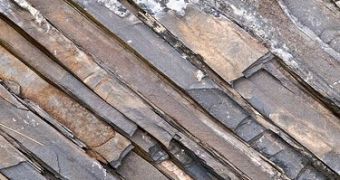A scientific drilling for natural gas trapped inside shale rock has been launched today, on the Danish island of Bornholm by the GFZ German Research Center for Geosciences along with the Geological Survey of Denmark and Greenland (GEUS).
This natural gas, methane, is trapped inside the dense claystone packages since the Cambrian era, some 500 million years ago, and even if it is considered to be an unconventional natural gas, it could be one of the future European energy sources.
This gas is also called shale gas as it is trapped inside shale rocks but like any methane, it comes from organic matter from plant debris deposits, that were trapped inside the rock and decomposed into oil and natural gas.
Shale is a very compact rock and its gas deposits are unconventional because this claystone has three functions: it is the mother rock in which the gas has formed, it stores the matured gas and it also acts like a cap that prevents the methane from escaping to the surface.
The 40 meters shallow drilling into the Alum Shale of the island will take three days, during which a second core will be drilled close to the first one for validating the results and at the end of which a geophysical analysis using 3-D seismics and water samples will be made.
As the geological conditions that lead to the shale gas formation and preservation in Europe have had very little investigation, researchers at the GFZ analyze these processes as well as potential deposits in Europe, in the international-scale research program called GASH, Gas Shales in Europe.
The current drilling will analyze the obtained cores using geological, geochemical, geophysical and geomechanical methods and hopefully improve our understanding on this matter.
GASH is a joint research that includes eleven individual projects and that, additionally, is developing a European-wide black shale database that will gather, for the first time, all the geological information available about black shale in Europe.
It is a project that will run for three years, from 2009 to 2012, coordinated by the German GeoForschungs Zentrum in collaboration with several European universities and research institutions.

 14 DAY TRIAL //
14 DAY TRIAL //